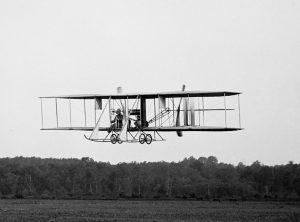The History of Air Cargo
The invention of the airplane by Orville and Wilbur Wright brought man’s desire to fly into reality. Shortly after their historical flight at Kitty Hawk in 1903, those promoting aviation began searching for feasible and lucrative uses for the airplane.
Today, planes serve not only as a quicker alternative for travelers all around the world; they are also responsible for the movement of millions of packages daily.
The Beginnings of Air Cargo
The first recorded air cargo flight took place on November 7, 1910. It was a delivery race between an express train and a Wright Model B aircraft. The cargo consisted of 10 bolts of silk which traveled from Dayton to a retail store in Columbus, Ohio. Pilot Philip Parmelee successfully flew the valuable load in 57 minutes, which proved to be faster than travel by train.
This was the very first “cargo only” flight, as it was strictly commissioned for transporting goods from point A to point B. It demonstrated the speed and viability of air freight. And since the silk was delivered from the aircraft to the store by automobile, it also was the first example of multimodal transportation.
Air Mail = Air Cargo
Airplanes that were used to carry cargo in the early 1900’s were not large or sturdy enough to carry substantial amounts of freight. Nonetheless, the military used planes during World War I to transport mail, medical supplies and some light essential equipment.
In 1918, regular airmail service began between Washington D.C. and New York City. Shipping cargo via airplane joined the airmail service in the 1920’s thanks to the formation of several new airlines. Their cargo was primarily high-priority mechanical parts or merchandise including jewelry, high-fashion clothing, movie reels, and pharmaceuticals. These items needed to be received quickly to meet critical deadlines.
The Upsurge of Cargo Flights
After World War II, larger planes and skilled pilots became available. The world entered a period of economic growth and globalization, and cargo operations increased. Several all-cargo companies were founded.
 Established passenger carriers began to realize the financial potential of air freight. They started their own cargo departments and began running all-freight flights to compete with the all-cargo airlines. Since the passenger airlines had established facilities and routes, they had lower fixed costs to transport cargo.
Established passenger carriers began to realize the financial potential of air freight. They started their own cargo departments and began running all-freight flights to compete with the all-cargo airlines. Since the passenger airlines had established facilities and routes, they had lower fixed costs to transport cargo.
Further tapping into the profitability of air freight, passenger airlines created a secondary market for themselves. They did this by carrying cargo in the lower deck of a scheduled passenger plane.
Today, nearly half of all air cargo is transported in the baggage hold (or “belly”) of a passenger aircraft. In contrast, the fuselage of cargo airplanes carry everything from frozen foods, miscellaneous perishables, construction equipment, automobile parts, and even complete cars. Pressurized cargo planes are utilized to transport livestock.
Air Cargo Regulation and Organizations
With the increase in cargo flights, regulations were put in place and have since evolved over time. Early federal safety standards started with the passing of the Air Commerce Act in 1926. This act was the first federal effort to regulate the growing aviation industry. It established safety rules for air traffic and pilot licensing, airworthiness certification for airplanes, and the investigation of accidents.
The Aeronautics Branch in the Department of Commerce was created under this act. Its primary responsibility was overseeing aviation in general. As the industry continued to grow and change, so did the duties and name of the Aeronautics Branch. Now known as the Federal Aviation Administration (FAA), this organization within the Department of Transportation is primarily responsible for regulating and overseeing civil aviation safety in the U.S., maintaining and operating air traffic control systems, and developing new aviation technologies.
Many organizations have been formed in support of the air cargo industry including two key international organizations. In 1945, The International Air Transport Association (IATA) was founded to establish global standards for air transport operations. To this day they continue to facilitate world trade by standardizing the transport of cargo. IATA’s Dangerous Goods Regulations (DGR) is the trusted source for the safe transport of dangerous goods by air.
The International Air Cargo Association (TIACA), formed in the 1990’s, is a non-profit group that represents the entire air cargo supply chain, including shippers, freight forwarders, ground handlers, and airlines.
Larger Loads, Faster Deliveries
The Boeing 747, designed and built purely for cargo, made its debut in 1968 and transformed the air cargo industry. It was the world’s first wide-body jet, allowing it to carry larger, heavier loads faster and farther than ever before. This greatly aided in the continued growth of air freight due to its ability to cost-effectively move large volumes of goods over great distances.
Consumer demand for fast, convenient delivery of goods lead to the creation of integrated air express carriers such as FedEx, DHL, and UPS. These companies developed door-to-door networks that combine air freight with ground transportation and advanced tracking systems.
FedEx truly transformed the air cargo industry by introducing overnight delivery using a hub-and-spoke system for package delivery conceived by its founder, Frederick W. Smith. With this method, FedEx uses its own fleet of aircraft to carry packages to a central location where they are quickly sorted and sent back out for delivery within hours.
Air Cargo Today
Undeniably, the astounding rise of e-commerce has had the greatest impact on the air freight industry. Retailers everywhere are following the success of business-to-consumer giants like Amazon and Walmart who cater to consumers wanting to shop from the comfort of their own home and have their purchases delivered directly to them in as little as one day. This rapid, reliable movement of goods from one country to another, and ultimately to the buyer, is now an established business practice connecting the world faster than ever before.
Do you need assistance in shipping cargo? Let Grand Aire put our 35+ years of expertise to work for you. Our Logistics Specialists are accessible 24/7/365 to provide you with the best air transportation options available. Give us a call at 1-800-70-GRAND or email our team directly at logistics@grandaire.com.
